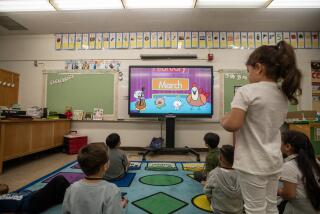In Hawaii schools, peer mediation rates an ‘A’ : Using students to solve student disputes teaches skills for managing conflict. It also helps keep peace.
- Share via
HONOLULU — As violence threatens to disrupt many American schools, some Hawaii students are finding that a solution may be in their own hands.
At Palolo Elementary School--a combustible mix of largely low-income students and immigrants in east Honolulu--children are less likely to punch it out on the playground these days. Instead, they’ll ask their classmates to mediate.
“Would you rather get busted or solve it yourself?” asked Ae Khounsourath, a slight 12-year-old who has broken up his share of fights. “The principal might give you detention. The conflict managers just make you feel happier.”
In 1987, Palolo became one of the first schools in Hawaii to try peer mediation. Since then, the voluntary program has spread to more than half of the state’s 240 public schools.
“Before we had the mediation program, kids were lined up outside the principal’s door with their fights,” said Palolo counselor Lynn Meguro-Reich. “It really has made a big difference. Now they take care of things themselves.”
Peer mediation is an inexpensive, staff-light effort to undercut violence before it starts--and give children practical skills for managing conflict. It trains students, starting in third grade, to step into their classmates’ disputes and help them find peaceful solutions.
“Dealing with conflict isn’t something we traditionally teach,” said Susan Chang, who trains elementary schoolchildren statewide. “But learning to maintain relationships is as important as learning to read.”
Similar efforts are taking place at schools across the country, as strapped administrators grasp for ways to curb violence. But Hawaii’s program seems to be one of the most widespread.
Although data is scanty, an effort to track one class trained in mediation showed a steady decline in the number of students involved in conflicts during their four years of high school, according to Janie King, state resource teacher in conflict management.
Hawaii may have an edge with the program because the level of violence in schools is relatively low to start with and the notion of mediation is not alien to the local culture. Hawaiians traditionally resolved family conflicts in a similar process known as ho’oponopono.
A recent survey of Hawaii schools indicated that the vast majority of incidents referred to peer mediators are resolved without administrative intervention, King said. Counselors and teachers report that because they have to handle fewer incidents, they have more time to do their jobs.
“Disciplinary problems have decreased appreciably,” said Joe Trimarche, counselor at Mililani High School, which has 2,400 students and started its mediation program in 1989. “I’ve had ninth-graders come in who were totally out of control. The mediators take them in for an hour, and it’s like magic.”
Students select classmates to be trained as mediators, indicating by secret ballot whom they consider trustworthy and fair, or teachers nominate potential mediators. Those chosen often are not the superstar athletes or academic standouts, but quiet ones who listen well, according to King.
Many of them have blossomed in their new roles. “They feel so honored to be selected,” Meguro-Reich said.
Mediators get clipboards and, in some schools, visors to help identify them. Other than the two trainers serving Hawaii’s elementary and high schools, and one staff member on campus willing to implement the program, little else is required.
Elementary school mediators receive four to six hours of training, while older students, with more complicated quarrels to resolve, train for two full days. Much of the time is spent role-playing. Some problems are off limits to student mediators, including drugs, weapons, suicide and abuse.
When a squabble breaks out, two mediators are assigned to the case. Each mediator interviews one side, then all come together to hash out a solution. The mediators remain neutral and don’t dictate justice. Instead, they ask questions to uncover common ground.
Once an agreement is reached, the disputants sign a contract, agreeing to do something as simple as not jump to conclusions based on rumors.
Some administrators have resisted the idea of peer mediation for fear that it will take too much time or undermine adults’ authority. It can be time-consuming, but the students’ solutions often parallel what an adult would have told the children to do. The difference is that the students come up with it themselves, giving them a feeling of control.
“I was skeptical,” Meguro-Reich said. “I didn’t think kids this age would be able to reason and go through the steps to get to the bottom of problems. But they do.”
More to Read
Sign up for Essential California
The most important California stories and recommendations in your inbox every morning.
You may occasionally receive promotional content from the Los Angeles Times.













